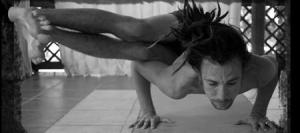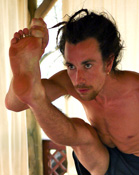 Sat 1st – Sun 2nd Sep 2012
Sat 1st – Sun 2nd Sep 2012
Check out Joey’s October weekend workshop in Hebden Bridge
I was really looking forward to Joey’s weekend workshop as I knew it would be inspiring, engaging and intense – and he didn’t disappoint! He likes to work people hard and has a really good understanding of the physics of the body but he also encourages a sense of exploration and enquiry into your practice.
Samasthiti: The art of verticality (Sat am)
The first session was a detailed examination of the standing sequence. We broke each asana right down, focusing on alignment and directionality, constantly questioning which way our hips, ribs, thighs, shins, etc. are moving in each posture. We also looked at the confusion caused by directionality when we move into a bend or inversion!
Joey continually encouraged us to be curious about our practice. He also invited us to practice vivisection of awareness of the body, focussing on each body part in turn, whilst always experiencing at least one breath as a whole, unified, being in each posture.
We did a lot of work exploring the movement of the shoulders and arms and were enlightened as to where our shoulders are located on the body (seemingly not where most people think!) We were also encouraged to lengthen and create space at all times in the spine, the ribs, the neck, the torso and the legs.
Chanting the Yoga Sutras and Pranayama (Sat pm)
After lunch we spent a couple of hours chanting some of the 1st chapter (Samadhi Pada) of Patanjali’s Yoga Sutras. We then broke down small sections of the sutras and looked at the meaning, interpreting how we could apply the guidance to our daily practice and every day lives in general. I found this fascinating as, although I’ve chanted the whole of the Yoga Sutras before (in Monica Marinoni’s Brighton workshop in June 2011), I’ve never really explored the translation in detail. I was struck by how relevant and meaningful Patanjali’s advice is, even in modern Western society.
We put one of the sections into practice as we briefly tried out the meditation techniques referred to in sutra 17. First we meditated on an object in front of us for a few minutes with our eyes open (vitarka), then we closed our eyes but tried to keep the object in our mind’s eye (vichara). Next we let the object go and meditated on a feeling of bliss conjured from a memory (ananda), and finally we let the bliss go and meditated simply on a sense of “I am” (smita). I found this a useful practice in developing a stronger sense of chitta vrtti nirodhah (the quietening of mental activity), which is the fundamental essence of yoga.
Counting Vinyasa in the Primary Series (Sun am)
 This was a led primary session practising the correct vinyasa to a Sanskirt count – or at least attempting to! Again, we broke down and repeated some sections, which included some partner work, to understand the count correctly.
This was a led primary session practising the correct vinyasa to a Sanskirt count – or at least attempting to! Again, we broke down and repeated some sections, which included some partner work, to understand the count correctly.
I found this really useful, as I had been counting through my own practice for a few months following a week of led primary with Sharath in London last September. However, I wasn’t sure I was counting correctly so I stopped, rather than get into bad habits. It turns out I was counting some of it wrong!
There are various breaths that don’t have a number assigned to them and various anomalies so it’s difficult to remember it all correctly. I had forgotten, for instance, that every seated posture begins on sapta (7) as this is what number you’d be on if you did a full vinyasa to standing between each asana. There are patterns, though, so the 1st side of a seated pose is always astau (8) and the 2nd side is always pancadasa (15). Joey encouraged us to remember this by constantly asking “What number are you on?”, which we sometimes managed to answer correctly!
Inversions (Sun pm)
I was feeling fine by Sunday lunchtime but the final session finished me off! It was all about inversions, namely shoulder stand, headstand and handstand. We explored lots of prep postures and exercises for headstand, which were mainly focused around the shoulders and upper arms. In particular, interlacing the fingers behind the back and pulling the shoulder blades together, as in Prasarita Padottanasana C, is great prep for shoulder stand. This encourages the action of standing on the musculature around the spine and tops of the arms, rather than standing on C7 at the base of the neck, as is so common in shoulder stand.
Joey explained that handstand is great prep for headstand and we experimented with kicking up against the wall (which I found impossible!) and working together to achieve a straight line against the wall so we could replicate it away from the wall.
Overall, it was an intense, but enjoyable, weekend. I learnt a great deal about technique, alignment, breath, Sanskrit counting and yoga philosophy, which I intend to try to apply to my own practice.
Thanks Joey for an inspiring and informative workshop!

[…] authorised teacher Joey Miles. This was the 2nd Brighton workshop of his I’d been to (see my post about his Sept 12 workshop), as well as countless classes at Buddhafield Festival where uneven […]